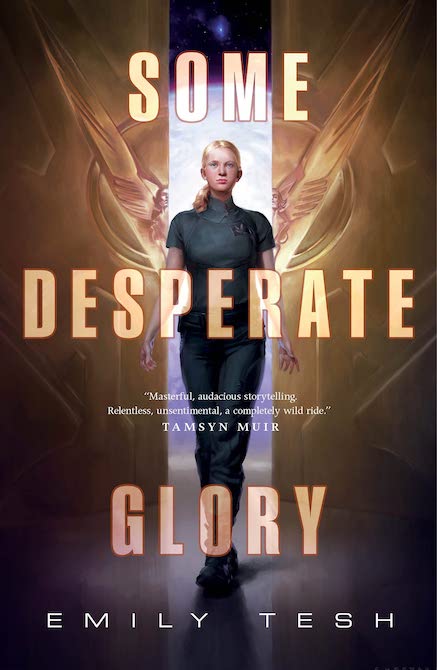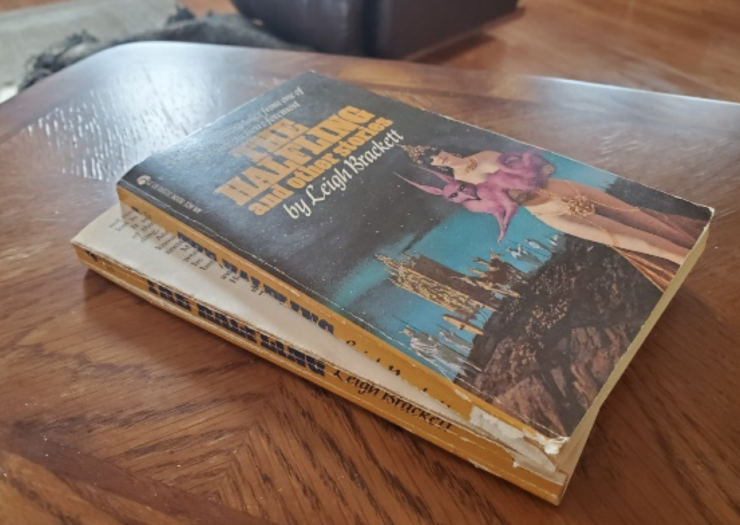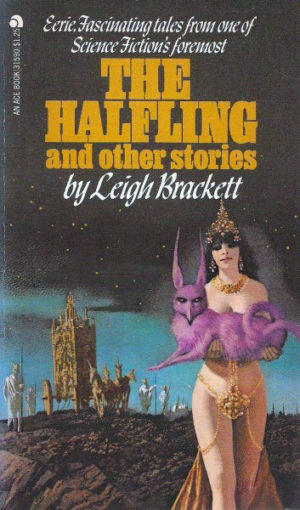In this bi-weekly series reviewing classic science fiction and fantasy books, Alan Brown looks at the front lines and frontiers of the field; books about soldiers and spacers, scientists and engineers, explorers and adventurers. Stories full of what Shakespeare used to refer to as “alarums and excursions”: battles, chases, clashes, and the stuff of excitement.
Over the past few years, I have been working my way through the stories of Leigh Brackett, a long-time favorite author. I’d been a fan of her planetary romance stories when I was younger, but less familiar with her other fiction. And recently, in a batch of Brackett’s books that landed in my local used bookstore, I found The Halfling and Other Stories, a collection of her stories that, with the exception of one, were new to me. And I’m happy to report that it is a collection with some truly outstanding tales in the mix.
Science fiction stories of the mid-twentieth century, which appeared primarily in magazines, tended to be shorter than many of the stories you find today. But the constraints on length had its virtues—the stories got to the point a lot more quickly, and were often lean and powerful. Writers like Leigh Brackett became adept at evoking scenes with a minimal amount of description, creating stories that grabbed the reader’s emotions within a very short word count. In more recent times, when most authors focus on writing novels (and novels that are two to three times longer than the novels of the old days, with narratives that often stretch across a series of books), these skills seem to be less common. As in the martial arts, where a single well-placed blow is worth a flurry of punches, these older stories have an energy and power that longer works often lack.
About the Author
Leigh Brackett (1915-1978) was a noted science fiction writer and screenwriter, perhaps best-known today for one of her last works, the first draft of the script for Star Wars: The Empire Strikes Back. I’ve reviewed Brackett’s fiction before—the omnibus edition Eric John Stark: Outlaw of Mars, the novel The Sword of Rhiannon, the novelette “Lorelei of the Red Mist” in the collection Three Times Infinity, the short story “Citadel of Lost Ships” in the collection Swords Against Tomorrow, the collection The Best of Leigh Brackett, the novel The Long Tomorrow, as well as her Skaith Trilogy: The Ginger Star, The Hounds of Skaith, and The Reavers of Skaith. In each of those reviews, you will find more information on Brackett and her writing. Like many authors whose careers started in the early 20th century, you can find a number of Brackett’s stories and novels on Project Gutenberg.
The Long Shadow of the Great Depression
In their book Generations, historians William Strauss and Neil Howe presented the theory that, shaped by common experiences and upbringings, generations throughout American history could be grouped into cohorts with common traits. Leigh Brackett, born in 1915, would have been part of what’s been called the G.I. Generation or Greatest Generation, and came of age during the hard times of the Great Depression and World War II. Her parents, in turn, would have been part of what is sometimes referred to as the Lost Generation, those who had seen the horrors of World War I, an inconclusive conflict that shocked the world with its savagery, a cohort known for their cynicism. My own parents are from the same generation as Brackett, and both were shaped by the Great Depression, especially my mother, who grew up on a small Midwestern farm where it was hard to make ends meet.
Brackett’s heroes remind me of the faces that stare out from black and white photos dating from the Great Depression. Pictures from the bread lines, from farms, from migrants trying to escape the Dust Bowl, and from applicants looking for work. Lined faces of grim people who lack hope—but at the same time, strong people who are still struggling to survive. People like Brackett’s most famous character, Eric John Stark, who was orphaned on Mercury. He was found and raised by native hill tribespeople in a harsh environment, who named him N’Chaka. That environment did not break him, but made him stronger. And when he was adopted by kindly government official named Simon Ashton, he was adaptable enough to learn to function in a completely different environment. He grew into a strong and clever man, and a fierce foe.
While they don’t wield swords like Eric John Stark did, Brackett’s other heroes have that same hardness and determination. They also share another characteristic. Beneath their flinty exteriors, they have kind hearts. Sometimes, the people they help are love interests, where their motivation is obvious. But Brackett’s protagonists also help the downtrodden, people who have nothing to give them in return. This is another characteristic associated with the Greatest Generation, a trait that helped them succeed in World War II—they took care of each other and worked together.
The Halfling and Other Stories
The first story in this collection, “The Halfling,” brought me both back into the past and into the future. The protagonist is John Greene, the bitter owner and operator of “Jade Greene’s Interplanetary Carnival Show, The Wonders of the Seven Worlds Alive Before Your Eyes.” The story evokes traveling tent circuses from the days of my youth, with the smells of damp canvas and cordage, the barnyard odor of circus animals, the flashing lights and loud barkers of the midway…the kind of circus that died out around the turn of the century. But this old-timey-seeming circus is one from the future, and features creatures and humanoids from the various inhabited planets and moons of the solar system.
Greene is approached by Laura, a beautiful woman who wants to become the show’s new dancer. On their way to a tent for her audition, she is frightened by Laska, a cat-man from Callisto, one of the circus’ biggest acts. Laura is a phenomenal dancer, and immediately raises the ire of Sindi, their current dancer, a Low-Canal Martian. Greene is immediately smitten by Laura, and chalks Sindi’s negativity up to jealousy. Greene hires Laura, and also a young boy who needs work, taking pity on them in light of their desperation. A few days later, however, Sindi ends up dead and Laska is killed when he attacks Jade in a frenzy. Then another circus worker, the recently hired young boy, is also found murdered. It is pretty easy to guess who is at the root of the problem, but this story is more about mood and atmosphere than it is about figuring out a whodunit. Greene, after opening his heart and letting his guard down, ends up even more embittered than when the tale started.
In “The Dancing Girl of Ganymede,” Tony Harrah is in the bazaar of Komar on the warm, volcanic moon of the title, where Jupiter fills half the sky. He sees a dancing girl who is beautiful, intriguing, and a bit menacing, with strange black eyes. Her name is Marith, which means “Forbidden,” so naturally, he falls for her (did I mention that Brackett heroes don’t always make wise romantic decisions?). Three men attack them, and while Tony tries to intervene, she is kidnapped. Tony meets her brother, and they set out to rescue her. Eventually Tony finds Marith’s secret, which is that she and her people are androids, hunted by the people who created them and are now threatened by them. Tony’s fate is now caught up with the fate of these mysterious creatures.
Buy the Book


Some Desperate Glory
In “The Citadel of Lost Ages,” a man named Fenway is being urged to remember his time in New York City, and to recall where the Citadel is. When he awakens, he is no longer in New York, but in a strange temple. He cannot remember his life. He catches a young woman named Arika, who remembers him, but he knows nothing of her. They are in the temple of a cruel people called the Numi. He kills one of their captors and they escape. He meets Arika’s people, and they help him remember his past. There was a dark star that passed near the Earth, and our planet became tidally locked to the sun. To preserve the knowledge of modern civilization, people built a Citadel, which holds the key to controlling the planet. Fenn is not from that ancient age, but the memories of one of the ancients have been imprinted on him. A race for the Citadel ensues across the mysterious dark side of the Earth, pitting Fenn and his new companions against the ruthless Numi, with control of the ruined Earth in the balance.
“All the Colors of the Rainbow” opens with a small midwestern hill town being engulfed with flood waters, the result of an out-of-control alien weather engineering project. The perspective then shifts to a young alien ambassador, who is traveling with his wife in one of the primitive local automobiles. He is looking for a room, a meal, and fuel for his vehicle, but faces hostility and racial epithets. A gang of young men force his vehicle off the road and attack him and his wife. He tries to tell them that their world is being opened to all sorts of interesting visitors, and people of all the colors of the rainbow, before he realizes that this is exactly what they fear. This being an older story, there are only hints, but there’s a suggestion that his wife is sexually assaulted by their attackers. And then the story loops back to where it began. The story, written in 1957, is a powerful statement against the prejudice that was so prevalent in that era, and even with the passage of the Civil Rights Act and other reforms, still plagues us today.
“The Shadows” follows the crew of an Earth survey ship on a newly discovered planet. It looks beautiful and uninhabited, but there is a strange area that looks like a city. The crew goes out to explore, and one of the older men, Barrier, sees shadows around them, and is immediately suspicious. He perceives it as a threat. They approach what proves to be the wreckage of an ancient city, and the shadows attack, with a cold and ferocious energy. But then there is another attack, and men begin to die—and Barrier realizes that all his assumptions are wrong. The premise of the story is turned on its head in a most satisfying way, and this story turns out to be one of my favorites of the collection.
“Enchantress of Venus” is a planetary romance adventure starring Eric John Stark, an excellent story, but the one story in the volume that I had read and already discussed in this column before. You can find that review here.
“The Lake of the Gone Forever” is set on Iskar, one of those small worlds you’ve never heard of that dot the skies of the solar system of the old planetary romances. Rand Conway arrives on Iskar, obsessively following a story his father told him about great riches that await whoever finds the mysterious lake. After a tough trek through the mountains, he and his companions enter an alien city. The inhabitants are hostile, but know something of his father. A young woman, Ciel, who is not like the others, agrees to lead him to the lake. And when he reaches the lake, after clashing with local warriors, Rand does indeed find riches, but they are not the physical rewards he had originally sought.
A mysterious ship lands in the woods near Hugh Sherwin’s small farm in “The Truants.” His daughter Janie comes home full of wild tales of angelic beings. She skips school to spend time in the woods, and entices her friends to join her. Hugh goes to check it out, and is stunned to see this is not a flight of fancy. There is a ship there, and alien beings who can speak by telepathy are trying to entice the children to leave with them. Hugh decides there is chance he can talk his way out of this problem. The story ends with one of those neat twists that we don’t see enough of any more (probably because all the good twists have been used), and instead of ending on a dark note, leaves the reader with a little smile.
Final Thoughts
Leigh Brackett was a master of her craft, and it was a pleasure to find a collection that featured such a wide range of stories. Her characters are hard and often bitter, but they are at their core good people, and as often as not, the stories end on a hopeful note.
If you’ve read The Halfling and Other Stories, or any of the individual tales in the volume, I’d love to hear your thoughts. And any discussion of Leigh Brackett and her other work is welcome as well. And I’m always open to recommendations for other planetary romance stories I should try out.
Postscript
One of the occupational hazards of reviewing old books is the way they tend to fall apart when you read them. Covers fall off, pages crumble or fall out, and spines crack. But I never before had one split in half right along the spine—until now, while reading a book called The Halfling, appropriately enough.

Alan Brown has been a science fiction fan for over five decades, especially fiction that deals with science, military matters, exploration and adventure.










